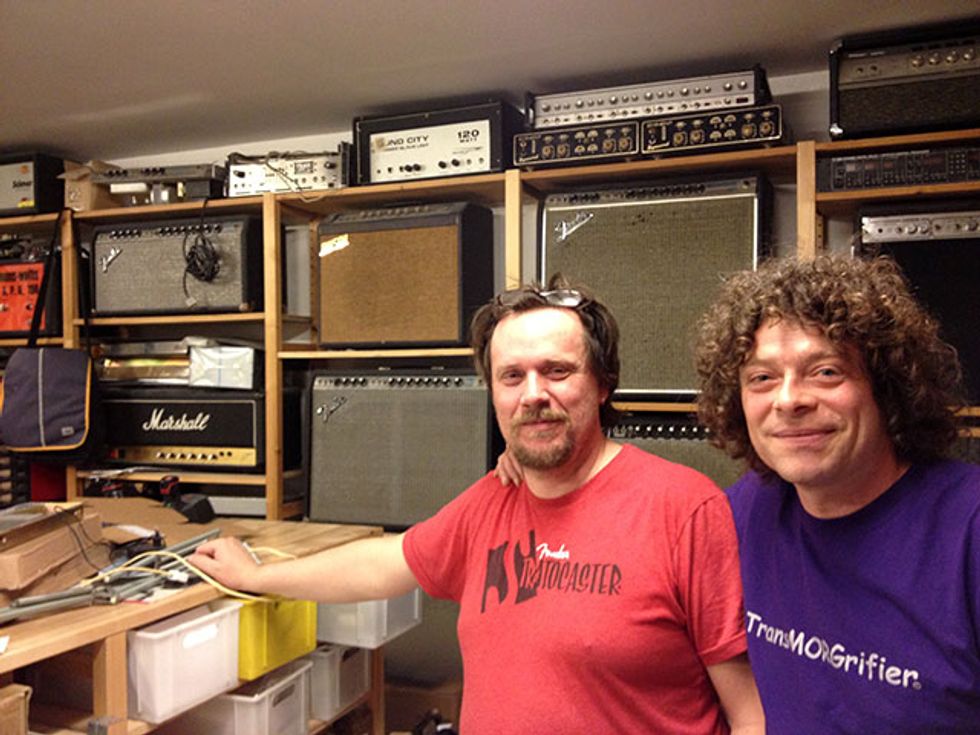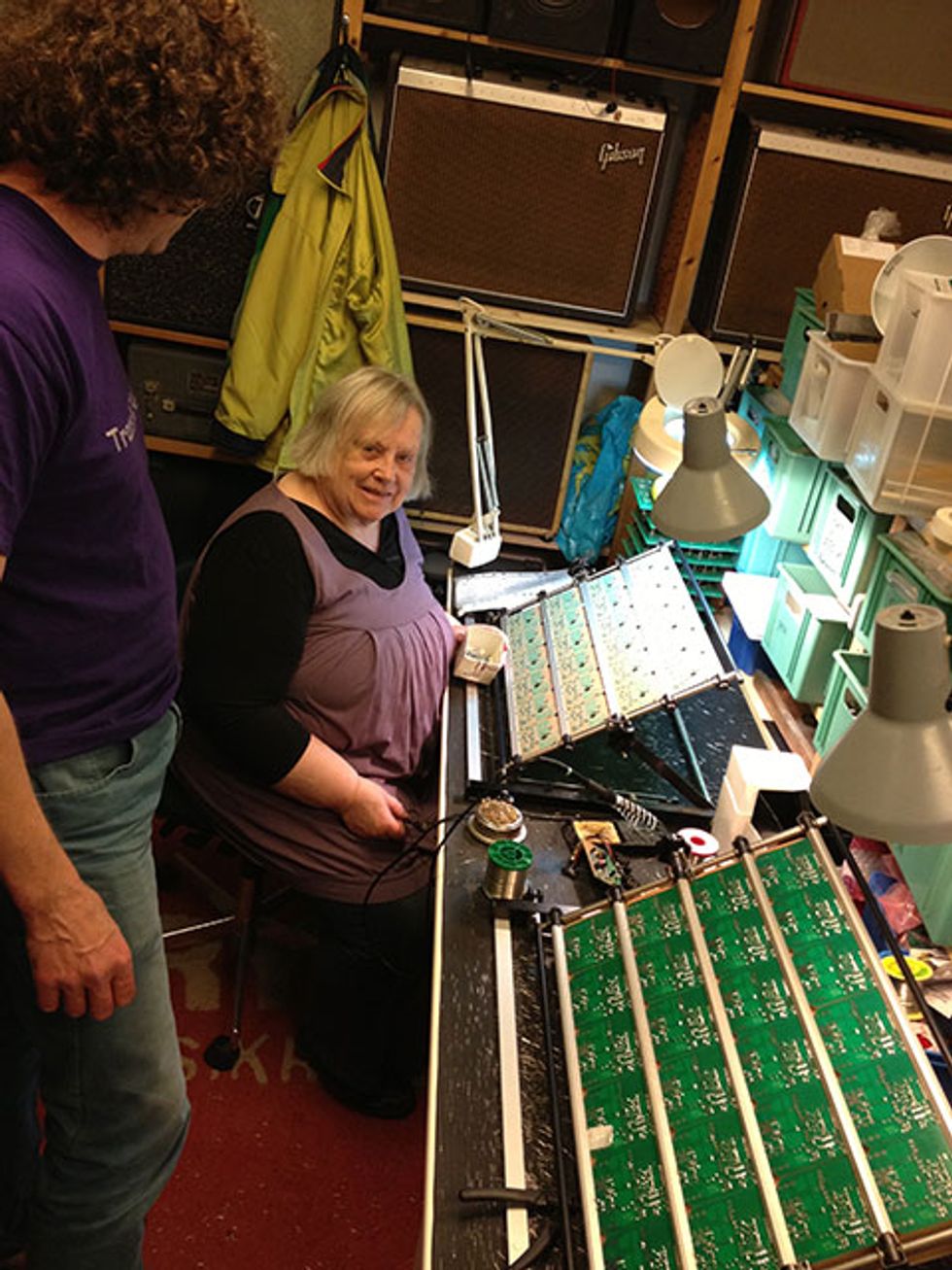What does a Danish kid do when he’s stuck in North Carolina on a brutally hot July day, when he’s had his fill of sleeping until noon, watching on-demand TV, and burrito binging? He learns to play guitar. What else?
Much to everyone’s surprise, the young Dane in question (my girlfriend’s brother, Laurits) was a very quick study, making it to barre chords less than a week after holing up in my studio with my guitars. So for Christmas I decided a Danelectro DC59 would do nicely. If it’s good enough for Jimmy Page and Syd Barrett, it’s good enough for anyone. The second half of the equation, the amp, would be from his parents, and, owing to the voltage requirements, would have to be purchased when we were next in Denmark. On the advice of my good friends Iris and Asgar, we dropped by Århus’ finest music store, Orkestergraven (Orchestra Pit).
Jan Behncke, the owner, greeted us, and showed us what was on the floor. After deciding on a nice, all-tube, Laney VC15, I had to ask …
“Jan, you sure have a lot of EMMA pedals in this place, are you a fan or something?”
“No, I’m EMMA,” he said.
Actually Emma is Jan’s daughter. But deep within the recesses of this wonderful music shop is where Jan and company manufacture their highly regarded pedals with their ridiculous sobriquets. In the same room you’ll find what’s quite possibly the finest collection of vintage amps in all of Scandinavia. Legendary amps by Marshall, Selmer, Simms-Watts, Sound City, Gretsch, Fender, Carlsboro, and Ampeg line the wall, along with some old Dynacord tape echos. It makes for an inspiring work environment—like assembling stompboxes in the Hall Of Kings.
Behncke (left) with EMMA employee Jesper Nielsen.
It’s at that point that Jan came up with (arguably) the perfect distortion, in the form of the well-loved ReezaFRATzitz. The secret of this pedal is its bias control, which pans from Class B to Class A tones, or anywhere in between. “I was using a TS-9 and a Tech 21 XXL Distortion at the time,” explains Jan. “So even though I had no particular tone in mind, they must have had an influence. What I was really looking for was something with a tight bottom, and soft, singing high end. I was working with Tim Campbell, and he named it.”
Collaboration is part of Behncke’s process, although he usually waits until the later stages of creation before bringing in outside opinions for fine-tuning. An exception was made when Behncke was building the PisdiYAUwot (which roughly translates, from Danish, to “thingamajig”). How do you say it? They made a convenient video to instruct you:
The goal was to make something that worked equally well for both classic, and modern, heavy rock. So Jan enlisted the help of Palle Schultz and well-known metal producer Tue Madsen (Dagoba, Sick Of It All). The result was a thick, heavy distortion that handles chords well, but is equally effective for solos and runs. “You need to be careful though,” Jan warns, “there’s so much clarity and lack of mush that you can’t hide your mistakes!”
Interestingly, the PisdiYAUwot is not true bypass. Famed pedal and pedalboard designer Pete Cornish’s (Queen, Pink Floyd, Paul McCartney) article called The Case Against True Bypass inspired Behncke, but should be required reading for anyone interested in effects chains. “We wanted to avoid using a run-of-the-mill buffer circuit. We designed a truly transparent buffer circuit, which we call ‘untrue bypass.’ It doesn’t cripple your signal and actually benefits the signal chain.”
How does Jan meet the ever-increasing demand for his pedals? EMMA users should take comfort in knowing that behind every pedal is a mother’s love. “Emma’s grandmom retired from her job, and very quickly got bored. She needed to get out and work again, so we trained her, and she started helping with production.”
Behncke's mother soldering circuit boards
Along with the six effects presently in the line, EMMA manufactures the AmARHyll pedalboard. It’s not available commercially in the U.S. at this time, due to a patent restriction, but can be ordered directly from EMMA. The AmARHyll is similar to other modern pedalboards, with it’s tiered design, but is unique in the fact that the extruded aluminum crossbars can be cut to any length, and then securely connected to end caps. The result is clean, sturdy, great looking, and organized (I’ve used one for years). “We are super proud of it,” Behncke writes on his website, exhibiting the company’s feel-good vibe—right above quite possibly the most hilarious assembly instruction video ever made (watch below).
These days, EMMA counts Adrian Belew, Warren Haynes, Steve Wynn, Jason Victor, Ida Funkhouser (Prince), Howe Gelb, Mike Miller, and Felix Pastorius among its customers. But what’s next? “We’re designing an amp, but I’m not sure when it will be done,” Jan says. “I’m an old fart who loves old tube amps. I’ve been collecting mainly Fenders, Selmers, and Gibsons for over 20 years now, plus I have this rare Marshall head. Only 250 were made. The plan is to eventually get them all in perfect working order, and lined up in the shop, so people can play them.”














![Rig Rundown: Russian Circles’ Mike Sullivan [2025]](https://www.premierguitar.com/media-library/youtube.jpg?id=62303631&width=1245&height=700&quality=70&coordinates=0%2C0%2C0%2C0)













